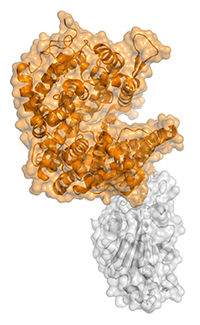FOR IMMEDIATE RELEASE | May 17, 2022
How three mutations work together to spur new SARS-CoV-2 variants
Like storm waves battering a ship, new versions of the SARS-CoV-2 virus have buffeted the world one after another. Recently, scientists keeping tabs on these variants noticed a trend: Many carry the same set of three mutations. In a new study in ACS’ Biochemistry, researchers examined how these mutations change the way a key piece of the virus functions. Their experiments show how this triad alters traits it needs to cause and sustain COVID-19 infection.
The virus SARS-CoV-2 has forced human cells to copy its genetic code innumerable times over the past couple of years, and, in the process, errors have emerged. These errors, or mutations, are the raw material for new variants. Scientists have found that nearly half of the genetic sequences within variants contain three mutations at positions called K417, E484 and N501. All of these changes tweak the same part of the virus, known as the receptor binding domain, which enables SARS-CoV-2 to infect human cells by latching onto their ACE2 protein. The widespread presence of this combination suggests that together, these mutations provide the virus with benefits not possible with a single change. Vaibhav Upadhyay, Krishna Mallela and colleagues wanted to tease out the advantages — and drawbacks — of each of these three mutations individually and in combination.
As a first step, the researchers produced domains containing the mutations and studied their effects in cells grown in Petri dishes. The team looked at how well cells could produce the domain, as well as the domain’s stability, ability to bind to ACE2 and ability to evade antibodies. The results showed that each mutation enhances at least one of these characteristics, but at a cost. The K417 change, for example, increased the production and stability of the domain, while also improving its ability to escape one type of antibody. However, it also decreased the domain’s ability to attach to ACE2. The other two mutations had differing strengths and weaknesses. But, when put all together, the changes mitigated one another’s negative effects. Domains with all three mutations could bind ACE2 tightly and escape two types of antibodies, yet also were produced at similar levels as the original virus and were just as stable. By revealing the details of how natural selection can favor a combination of mutations, these results offer new insight into virus evolution, according to the researchers.
The authors acknowledge funding from the University of Colorado Skaggs School of Pharmacy and Pharmaceutical Sciences.
To automatically receive press releases from the American Chemical Society, contact newsroom@acs.org.
Note: ACS does not conduct research, but publishes and publicizes peer-reviewed scientific studies.
Media Contact
ACS Newsroom
newsroom@acs.org

View larger image

